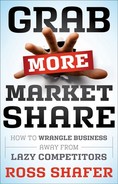Chapter 5
Which Trusted Advisors Will Lead the Recovery?
Most Trusted Advisors Miss the Point
Almost every C-suite executive has read David Maister's book on the subject, aptly titled The Trusted Advisor. They have caught the bug and now want the infection to go airborne. This movement is significant, because encouraging all salespeople to become trusted advisors is akin to making the not-so-secret admission that e-mail, voice mail, IM-ing, texting, and most forms of electronic customer relations management (CRM) software just aren't cutting it. Organizations that want to take business away from a competitor are getting back to the face-to-face basics.
I'll start by giving some examples of what a trusted advisor looks like in practice, and then we'll get into the nuts-and-bolts skills and behaviors required to master this art.
Before Ramani Ayer retired as the CEO of The Hartford Insurance Company in 2009, he told me the following: “The future is not electronic. It [requires] getting more feet on the street. I want every agent and associate to stop staring at their CRM dashboards and get out of the office. I want them to spend 65 percent of their time with their customers.”
Jon Magnusson, chairman and CEO of renowned Seattle, Washington–based structural and civil engineering firm Magnusson Klemencic Associates, has planned and built some of the most stunning, award-winning projects in the world. MKA's designs include stadiums that hold 72,500 people, 48 museums in 11 states and three countries, urban towers and stacks to 112 stories, luxury hotels, and 40 convention centers totaling 18 million square feet. Suffice it to say that MKA has a stellar reputation. With a matchless track record, you wouldn't expect that this company would have to work that hard for business.
But it does.
As Magnusson told me, “We never take our business for granted. We have 7,000 active accounts and we treat everyone like he or she is our best friend. We believe in very long-term relationships. But it doesn't come by accident. People trust us because we work hard to keep our promises, and we do excellent work.”
I love to use examples from the commercial building trade, because it was a segment that was hit the hardest in the credit crunch of 2008–2009. So many companies in that space went under, but the solid ones that weathered the storm and kept growth in mind are inspiring.
General contracting company Mortenson Construction received the 2010 Wisconsin Design-Build Project award, a national award conferred by the Design-Build Institute of America (DBIA). It's a bit deceiving, because Mortenson is a $1.2 billion a year company responsible for large building construction all over the planet. President and CEO Tom Gunkel says, “We don't assume our relationships or reputation will win the job. We put our A Team in the presentation. We are ‘fee competitive.’ We do our homework [each time] like [we're working on] the first bid we've ever done.”
The A Team to which Gunkel is referring is made up of the company's top dogs, its most articulate communicators, who can answer every question with confidence and experience. That group represents the trusted advisor concept at the highest-performing level.
